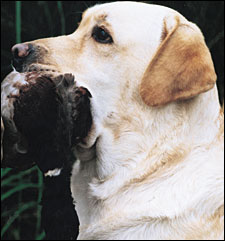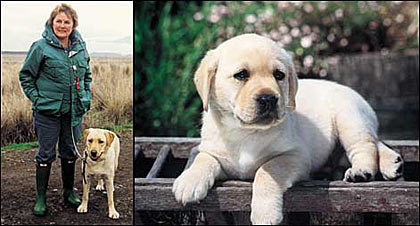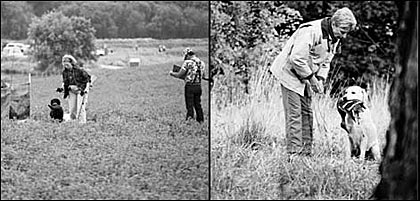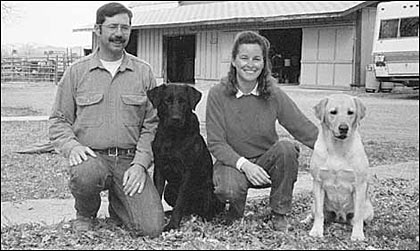Good Looking Shooting Dogs With an (Appealing) Attitude
By James B. Spencer
When Jane Border started looking for a Lab shooting dog more than 30 years ago, she was a blessed or cursed (your choice) with an eye for canine symmetry and a feel for canine temperament. Thus, she couldn't be satisfied with "just" a shooting dog. No, her dog must also look like a Labrador should look and act like a Labrador should act. That was a tall order, even back then. Small wonder she became a breeder who, for many years now, has been breeding Labs "her way," under her Braemar kennel name.
The results? Quite gratifying. Although she can't remember exact numbers, she said her dogs have won more than 30 show championships, more than 30 obedience titles and more than 20 hunt test titles. A few have become "assistance" dogs (guide dogs, and so forth).
However, Jane places most Braemar Labs in hunting homes, where they fit in as shooting dogs and family pets. Her focus on this type of dog led her into professional training. She personally trains a limited number of Labradors and conducts training classes to teach beginners to train their own dogs.
"This is not field-trial training," she emphasizes, "just ordinary hunting stuff: force-fetch, handling birds, upland flushing, single marks on land and in water and so on."
As you would expect, Jane judges hunt tests. Then, too, because of her instinct for conformation, AKC has licensed her to judge Labradors and most other sporting breeds in dog shows. She is on the Board of Directors of the Labrador Retriever Club, Inc. (LRC), which is the national breed club sponsoring the Lab in this country.
 Not only are Braemar Labs pleasant to look at, but they handle field work with ease and style. Raintree Braemar Brigadoon, retrieved over 300 birds in his first hunting season. |
BRAEMAR CONFORMATION
"It doesn't cost any more," Jane often says, "to feed 'pretty' dogs." So she breeds "pretty" Labs--medium-sized, nicely balanced and attractive. They have substance, without being ponderous like Newfoundlands. They are athletic without being willowy like greyhounds. Jane breeds proper working conformation, ignoring dog-show fads, which in recent years have favored dogs with too much substance as well as dogs with too little leg. She calls the former "boat sinkers," the latter "squatleys."
"Squatleys wear out quickly, can't do a day's work afield," Jane said. "Boat sinkers swamp the boat when they climb aboard after making a retrieve. My dogs have enough leg to go all day, and they won't put your boat in Davy Jones' locker. Dog-show fads go around and come around, but a well-balanced dog can still win the points in the ring."
"Jane breeds for a functional dog," said Debi Stevens, a pro-fessional obedience trainer in Colorado, who has had Braemar Labs for over 10 years. "My husband, Jim, is the most fanatical hunter you'll ever see. We go early and get back late. Except for a short lunch break, we hunt hard all day. It takes a thoroughly sound dog to keep going like that, as our Braemar Labs do."
"They're nicely balanced overall," said Susan Biddulph of Pennsylvania, who has had Braemar Labs for over 25 years. "Their height and length are properly proportioned."
COAT
Jane breeds both blacks and yellows. In either color, her dogs have working coats. The short, flat, rather harsh outercoat sheds water, thereby protecting the dense, woolly undercoat that insulates the animal.
"When I hose my dogs down," said Susan Martin of California, who has had Braemar Labs for more than 10 years, "it's difficult to get the undercoat wet because the outercoat protects it so well. I have to use a brush to get water into the undercoat."
Stevens mentioned that when she and her husband were married, he had a Lab (not from Braemar) that lacked this double coat. She said the dog was a wonderful hunter, but it suffered a lot in cold weather duck hunting. Not so for their Braemar Labs, she said--their undercoats stay dry during water retrieves.
TAIL
Braemar Labs have the "otter tail" that is so admired in the show ring. Jane likes it and breeds for it but doesn't consider it a priority item. Still, it's attractive as well as somewhat functional. Contrary to popular myth, it doesn't act as a rudder to steer the dog in the water. But it does give the swimming dog better balance, and it adds a little extra propulsion.
 LEFT: Jane Border with Braemar Rhimbo Hanalei Bay JH. RIGHT: A typical yellow Braemar puppy shows off the classic Braemar Lab head at an early age. |
"I love the Braemar otter tail," Martin said. "When the dog swims, you can see the tail moving back and forth rhythmically, just under the surface."
HEAD
Perhaps the most distinctive physical feature of Braemar Labs is the blocky head with a deep muzzle and a kindly expression. Obviously, this is a good working head, one that can carry any bird an owner is apt to send his dog after. However, it's more than that. It contributes greatly to the appearance of the dog.
"Most lines have some physical feature by which you can recognize them," Jane said. "In my Braemar line, that feature is the head. I'm very fussy about good heads."
"They all have gorgeous heads," Biddulph said, "nicely balanced, with what my kids call that 'hungry puppy-dog expression.' They look at you expectantly, almost adoringly."
"Every Braemar dog I've ever seen," Stevens said, "has had an absolutely extraordinary head."
HEREDITARY HEALTH PROBLEMS
Like most breeds, the Lab suffers from several hereditary health problems, such as hip displasia, elbow displasia and various eye problems. To help breeders eliminate these plagues, several veterinary organization provide clearance certificates for unaffected dogs. Orthopedic Foundation for Animals (OFA) and PennHIP certify hips based on X-rays. OFA also certifies elbows from X-rays. The Canine Eye Registry Foundation (CERF) certifies eyes, based on examinations by Board Certified vets. Jane is extremely conscientious about certifying her breeding stock. In fact, she was a pioneer in addressing Labrador elbow problems, which many breeders have only recently acknowledged. . .and some still don't understand.
"All my stock is hip, eye and elbow certified," Jane said. "Elbows are a huge proble
m in Labs, perhaps because so many show people are breeding short, squatty dogs. I've been X-raying elbows for 20 years."
 LEFT: Susan Martin with her Braemar Lab, CH Desert Guide Arden JH CD WC SR CGC, at the line in a hunting test. RIGHT: Susan Biddulph receives a duck from Cumberland Fiona of Braemar JH. |
TEMPERAMENT
The traditional Labrador temperament--happy, friendly, eager to please, attentive and enthusiastic--should delight almost anyone. Unfortunately, the breed's great and growing popularity makes that "traditional" temperament less and less "typical." For nine consecutive years now, the Lab has been America's most popular breed, by a wide and growing margin. In 1999, AKC registered almost 155,000 Labs, more than twice as many as the second-place breed, the golden, with almost 63,000. Such popularity encourages fast-buck operators to pocket one jackpot after another from haphazard breedings. Mostly, they produce dogs that are not only "functionally challenged" and mud-fence ugly, but also "temperamentally deprived." However, Jane Border continues to breed Labs with the traditional Labrador temperament.
"I won't tolerate an aggressive dog," she said. "Unfortunately, with so many Labs being bred, bad temperaments are not uncommon today. Many novices seem to think all Labs are good Labs. That's like thinking all used cars are good used cars. I breed dogs that want to please and can take normal training pressure."
"Braemar dogs," Martin said, "are thinkers, not dumb blondes. They think their way through retrieving problems, so training them is easy. Temperament is my number one priority, and I've never had a problem with Braemar Labs. No bitch fights. No problems with other dogs. No problems with people. Toddlers crawl all over them and they love it."
"I've never had a Braemar dog that wasn't a wonderful house dog," Stevens said. "Their whole goal in life is to please you, and they're easy to train. In the obedience classes I teach, I deal with over a thousand dogs a year, including many Labs, so I see a variety of temperaments, even among the Labs. To me, the Braemar temperament is without equal."
"They want to please you," Biddulph said. "They're biddable. They have brains. They're easy-going--until it's time to work in the field. Then they're quite lively."
AS A SHOOTING DOG
Not only are Braemar Labs mentally and physically sound, but they also have strong retrieving instincts, good noses, marking ability and style. Those traits, combined with their strong desire to please, makes them a joy to work with. With minimal training and exposure, a typical Braemar Lab will do most of what the average hunter wants done.
"My Braemar dog, Arden (CH Desert Guide Arden JH CD WC SR CGC)," Martin said, "earned her JH hunting test title with very little formal training--just a few training sessions with a group. Until three days before her first test, she had never even seen a duck! She was an absolute natural."
"My nationally ranked obedience trial dog, Buff (Sunshine's Buff of Braemar CDX JH)," Stevens said, "earned her JH title in five tests with absolutely no formal field training. My husband and I had hunted her extensively, but we had never actually trained her for field work. Buff was a great hunter. In upland hunting, she figured out that my husband, being a better shot, knocks down more birds than I do, so she hunted mostly in front of him. When I'd call her over, she'd stay with me briefly, then slip back over to Jim."
RETRIEVING INSTINCT & BIRDINESS
It has often been asserted, sometimes by people who should know better, that the slightest brush with the dog-show world erases all natural hunting instincts. That has not been the case with Braemar Labs. From early puppyhood, they love to retrieve and are nutty about birds.
"I test my litters early on birds," Jane said. "The results are gratifying. Of course, I personally prefer the pup that grabs the bird and tries to keep it away from the rest of the litter. I work all my puppies on birds and in water regularly, right up to the day they go to their new homes."
"My Braemar dogs," Stevens said, "have been retrieve-aholics from day-one."
 Jim and Debi Stevens with two Labs. Jim's black isn't a Braemar Lab. Debi's yellow is Sunshine's Buff of Braemar CDX JH, the dog that earned its JH without formal field training. |
"They have a strong carrying instinct," Biddulph said. "When you go to the house of someone with a Braemar Lab, chances are the dog will have a toy or something in his mouth when he greets you at the door."
"My youngster Braemar, Dance with the Devil, retrieved his first duck at four months of age," Martin said. He watched the older dogs, and seemed to say, 'Shucks, I can do that!' Then he jumped in, swam out, and hauled the duck back."
NOSE
Because of the nature of their work, retrievers don't need the extreme olfactory acuity of either hounds or pointing breeds. How-ever, a working retriever should have at least a passable nose if he's to find even the birds he has marked accurately, because not all shot birds "drop dead," so to speak, and lively cripples frequently run quite a distance. Not surprisingly, Braemar Labs have noses considerably better than passable.
"One chukar we shot for Arden," Martin said, "fell on the far side of a hill. Arden went over the hill and hunted out of sight a long time. Several times she crested the hill briefly, then went back down the far side. Finally, she returned to the top of the hill, and her front half disappeared from sight. When her head popped back up, she had the chukar in her mouth. After falling, this bird had run back up the hill and crawled into a hole. Arden tracked it to the top of the hill several times before figuring out where it went."
MARKING
"I breed for good marking," Jane said. "I use many Master Hunters as studs. When I breed to a show dog, I first make sure he has good working ability, especially that he can mark." "In her entire life," Stevens said, "my Buffy never failed to retrieve a downed bird. She marked very well, and she had an excellent nose. Between her marking ability and her nose, she brought back every bird we shot for her, which, incidentally, was a lot of birds."
STYLE
Another common knock against show-type Labs is that they're "pigs," that is, plodders or dogs with no style. Such is not the case with Braemar Labs. They work rapidly and enthusiastically and, because of their functional conformation, they don't tire themselves out doing so. And, of course, they're beautiful to watch.
"My dogs are pretty fast," Jane said, "without being hyper. They aren't high-rollers, but they have plenty of drive, because they're birdy. They want to get the birds."
"Whether in the show ring or in the field," Martin said, "Braemar Labs have wonderful 'presentation.' In the field, they do everything with gusto. They go into the water with a long, flying leap."
PLACING PUPPIES
Jane breeds only about three litters a year, and she raises the puppies in her kitchen. She handles each puppy every day and challenges them with tunnels, stairs, various noises, trips to the store and so forth. When they leave at about eight weeks, they're ready for whatever new exposures they may encounter. Jane places her puppies carefully.
"I don't have a lot of new clients," she said. "Mostly, my puppies go to people who have had Braemar Labs for years. One thing's for sure: I won't sell a puppy to anyone who plans to make it a kennel dog. All of my personal dogs are house dogs, and I want my puppies to be house dogs, too. Dogs don't develop properly if they're kept outside in a kennel all the time. Before selling a puppy, I want to know what kind of situation he will be going into, how much training the people will give him, and so on. I match the puppies to their new owners. I know each puppy quite well, so I can determine better than anyone which puppy is best for each situation."
For more information about Braemar Labradors, contact Jane Border, 416 Horn Avenue, Santa Rosa, CA 95407-8248 or call her at 707/584-0154.






